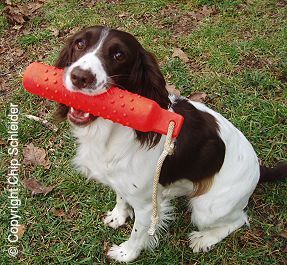

The humidity was incredible for late June in this Northern Virginia suburb of Washington, DC, and the sweat rolled off my brow stinging my eyes. The mosquitoes buzzed thickly around and feasted on the tender morsels of the bare flesh of my arms and legs. The air, hazy and motionless, only added to my misery as I held the slip lead that was securely attached to Dixie’s neck and maneuvered her into position on the bank of our neighborhood pond. She started forward triggering an exodus of frogs into safety of the waters along the thick weeds of the bank, but I managed to retain control of the lead. As the sweat trickled off my nose, I mused that this was going really be difficult.
How was I going to hold onto her while simultaneously tossing a retrieving dummy into the pond? The small springer, not yet line steady, was already straining at the bit to get into the pond.
I solved the problem by stepping on the lead and quickly tossing the dummy into the pond about twenty yards out. I thought Dixie would strangle herself as she fought against the lead to get to the dummy floating just beyond her reach. As I struggled to remove the lead, she wriggled out of the leash and launched herself into the water. Her puppy strokes had not improved with the spring hunt test season and the moment her feet left the small submerged shelf that closely hugged the bank, her bottom sank. She began flailing as before with her front paws toward the floating white knobby dummy. Dixie’s determination, however, won out over her poor swimming style. Painfully and relentlessly the young springer paddled toward the dummy, reached it, grasped the object of her desire, and started swimming back toward me.
I swatted another mosquito, smearing the insect and a little blood on my neck and watched the spaniel swim back to me with now smooth strokes - the dummy in her mouth forcing her to swim in an efficient dog paddle.
Dixie’s delivery of the dummy was not a thing of beauty. Upon reaching the bank, she did the canine equivalent of kissing the ground - she dropped the dummy and shook the water off of her coat. She then picked the dummy up, pleased no end with her performance, and did a victory lap or two around me. I immediately dropped to one knee, looked down on the ground (not at her) and sought to lure her to me. After about five minutes of (how should I put this delicately) "frivolity", she tired of her antics, brought the dummy within about a step of me and dropped it. I picked the dummy up and we began again.
It is time for true confessions at this point. In my initial retrieving drills with Dixie, I did patiently lower myself to my knees and coax her in to me. I had initially, to my everlasting regret and shame, lunged for her and grabbed her by the scruff of the neck when she first arrived home. This, to say the least, is not the preferred method of improving your spaniel’s delivery. Moreover, in Dixie’s case it caused more problems than it solved. I was forced to reconsider my approach. After much consultation with Tony Roettger on this issue, we decided on the kneeling and coaxing approach. It worked in Dixie’s case, but it took a lot longer than it would have had I started working with her in this manner rather than the "catch and yank" technique I had mistakenly used previously.
We worked assiduously on retrieves that day with good progress on swimming and deliveries, calling it quits only after I, in the process of a wind up for a long dummy throw, slipped on the now very wet and slippery steep dam face. I slid "hat, ass, and spats" down the muddy bank on my posterior with Dixie looking on with a smug expression. Catching a blackberry bush with my foot, I somersaulted ungracefully into the water - landing with an enormous splash. Turtles scattered and Canada geese flew in response to my artless gymnastics. Dixie remained nonplussed. I swear I could detect what would pass for a smirk on her face. Returning home - dog and man thoroughly soaked - Door, my loving spouse, wordlessly directed us, arm outstretched and with pointed index finger, to the backyard spigot for a thorough hosing down
to remove scum, mud, and pond water stench.
"In my mind, there is no substitute for dogged, relentless diligence in dog training."
So it went for the remainder of the summer. We worked diligently on Dixie’s water skills. I believe that we practiced two or three times a week with our sessions limited by my travel schedule, the weather and Door’s tolerance of wet dog smell (she has a high tolerance for this I have found). During the summer, Dixie made the transition from a puppy swimmer to a mature swimmer. As her confidence grew, I gradually lengthened the distances of the retrieves. She had started out with fifteen to twenty yard retrieves and by the end of the summer she was easily retrieving dummies tossed thirty to forty yards, limited only by my lack of a pro quarterback arm. In my mind, there is no substitute for dogged, relentless diligence in dog training.
In addition to increasing her distances, Dixie, through the course of the summer, became line steady to thrown dummies. I had started in the backyard "hupping" her in front of me while she was on a slip lead and tossing the dummy behind me. I kept my body positioned between her and the dummy to block her should she break and holding the lead as a last resort to check her from completing the retrieve if she broke. Gradually, I moved her to my side, and slowly but surely, Dixie steadied up to tossed dummies. When she was thoroughly steady in the backyard with no breaks, I took her to the pond. The first few visits, I kept her on the slip lead as I tossed a dummy short distance into the pond. Only after she was completely steady (no creeping allowed) did I introduce her to double water retrieves.
By summer’s end, she was doing a very good job of retrieving double marked water retrieves using orange dummies at distances of about thirty five yards with the dummies separated by about sixty yards to help stimulate her memory.
If Dixie is any indication of the breed, field bred English springers, I have found, are possessed of an incredible retrieving drive and are capable of retrieving to exhaustion (I have found that this is not necessarily the case with Arwen, my field bred English cocker, who seems to become bored with repetitive retrieves). Dixie and I worked retrieve after retrieve, but never more than about ten, which many spaniel trainers might think would be excessive. However, Dixie never lost her enthusiasm for water work and I was beginning to feel very good about her chances at the water should she move up to the senior hunter category.
To further prepare her for senior hunter and as a relief from the water work, I began preparing her for the senior hunter "hunt dead" test and would even incorporate "hunt dead" training as we walked to the pond. Initially, I would surreptitiously drop a dummy behind me when she was "heeling" ten feet in front of me paws flailing and striving mightily to get to the pond before I did. After dropping the dummy, I would go ten yards or so further with her, turn her around, give her a rudimentary "line" to the dummy and release her with her name. I would then say "dead bird" almost immediately after releasing her. She quickly picked up that a dummy was out there and as the summer progressed we lengthened the distances. It was at this time that we also began to work basic hand signals. After steadying Dixie to thrown dummies,
I began playing "baseball" with her. In the neighborhood common area, I would "hup" the springer on an imaginary pitcher’s mound in the middle of the common area and throw dummies to (again imaginary) first, second and third bases. She caught on quickly to this drill and wanted to play it endlessly. I held our sessions to no more than ten retrieves.
Dixie’s "baseball" training has become a source of tremendous neighborhood amusement and entertainment. Our sessions have attracted much attention from the Yorkshire terrier, Pekinese and bulldog crowd who stroll and prance on the sidewalks adjacent to my training area. Often spectators will come right up to me and ask, as one owner did, "Say Chip, do you think Fluffy (the Yorkshire terrier) could do this?" My response was typically bumbling, "Uh... gee Bob, I am not sure that Yorkies do that, but... um... ah... heck, you could give it a try." My quizzical expression no doubt betrayed the fact that I was mentally reviewing gun dog training supply catalogs as I inarticulately responded to his question. My mental gymnastics failed to uncover any manufacturer offering diminutive hot dog-size retrieving dummies or wrist watch-sized e-collars.
The heat and humidity gradually, inexorably gave way to the beginnings of fall. In Northern Virginia, there is always a break from the dog days of summer that occurs usually in late August. The cooler weather generally lasts for only a couple of days before returning to the swelter of the South, but it is enough to signal the imminent change of the seasons. Dixie was now rapidly approaching the level of training required to have at least a shot at a leg or two of the senior hunter test - and I virtually beamed in anticipation of the hunt test and hunting season. This was progress, distinct progress.
Part II Part III
|
|
| Bookstore | Bill Fawcett Reviews | Advertise on SJ | Classifieds | Resources | Events | Point Standings | Archives | In Memory | |
|
|
Copyright © Spaniel Journal & L Baughan Webdesign, 2002-2006, all rights reserved worldwide |
|

